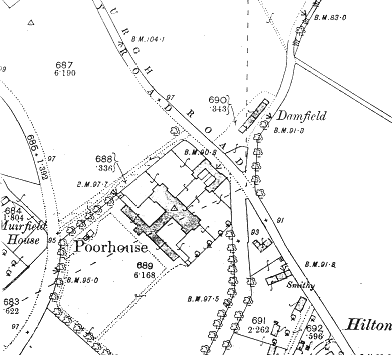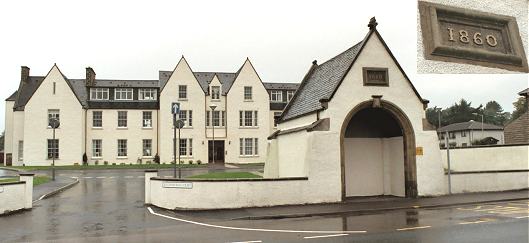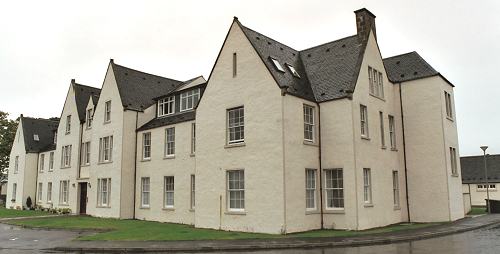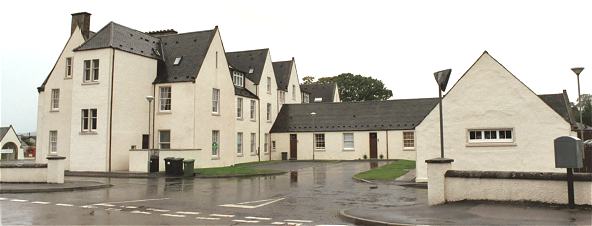Inverness, Inverness-shire
Inverness poorhouse was built in 1859-61 on an 8-acre site at the west side of the Old Edinburgh Road (also known as General Wade's Military Road) at the south of Inverness. It was designed by James Matthews and William Lawrie. The poorhouse location and layout are shown on the 1866 map below:

Inverness site, 1866
A U-shaped block stood at the eastern entrance to the site. This probably contained a porter's room, and the relieving officer's office. The wings may have contained male and female probationary wards. Only the central archway now survives.

Inverness entrance from the east, 2001.
© Peter Higginbotham.
The main building was a typical H-shaped layout. The larger block at the front was a corridor plan building with a central portion which would have contained the Master's quarters, committee rooms and clerk's office. The poorhouse dining-hall and chapel were located in the central block at the rear. The two wings of the front block contained male and female accommodation, probably with the aged at the front side and able-bodied or "dissolute" inmates at the rear. Children's quarters were usually placed at the far end of each wing. In the rear range of single-storey buildings were found various work and utility rooms including a bakehouse on the men's side and laundry on the female side.

Inverness main building from the north, 2001.
© Peter Higginbotham.

Inverness main building from the north-west, 2001.
© Peter Higginbotham.
Inverness poorhouse was later known as Muirfield Institution. In 1946, an official report noted that the building had narrow central corridors and poorly lit but well ventilated wards. Its accommodation then included 54 beds for the chronic sick, 3 maternity beds, a nursery ward for 6 children, and places for certified mental patients. Under the National Health Service, the Institution became Hilton Hospital.
The buildings have now been converted into flats.
An interesting insight into what conditions may have been like at the Institution comes from a story kindly contributed by Jennifer Howie:
My family are from Inverness. My father would have left school about 1948 and he went to work for the local ironmonger, Fraser & McColl.
As was the way in those days one shop covered many lines and this company also sent men to lay Lino. My father was sent with a couple of more senior men to lay Lino at the Poor House at Hilton. He tells me that the hospital was so cold that the men had to use blow torches to thaw the oils in the Lino each morning so that they could unroll the material in order to cut it. It became obvious to them that although the blow torches worked to unroll the stuff they were not of any use in the laying of the Lino. They, therefore, had to instruct matron to have a fire lit in the room where the Lino was stored so that they could come back the next day and have a material supple enough to lay. Throughout the duration of the job the room containing the Lino was the only heated room in the Hospital.
My father says that he lost quite a bit of weight during the job as he found the conditions so dreadful that he was put off his food. He says that the patients were urinating everywhere and the men doing the job of laying the new floor covering had to crawl about in the mess and try to clean up as they went in order to have a clean surface on which to lay the Lino. Dad says that the conditions there were the worst he ever saw and he longed to forget the experience. However, his mother was wanting a piece of new Lino for the back room and there was some left over from the job at Hilton, so my father's boss told her she could have the left over piece. The Lino was 3/8" thick and made to last, so for the rest the years during which my family lived in Broadstone Park, some 40 years, Dad had to look at the Lino and remember the awful job of laying the stuff at Hilton.
In the late 1970s I went to Inverness to train as a nurse and one of my secondments was to Hilton Hospital. The Lino was still there!
Staff
Inmates
Records
Note: many repositories impose a closure period of up to 100 years for records identifying individuals. Before travelling a long distance, always check that the records you want to consult will be available.
- Highland Archive Service, Bught Road, Inverness IV3 5SS, Scotland. Holdings include: Admissions registers (1861-1953); Death registers (1909-38); House Committee minutes (1861-1910).
Bibliography
- None.
Links
- None.
Unless otherwise indicated, this page () is copyright Peter Higginbotham. Contents may not be reproduced without permission.


